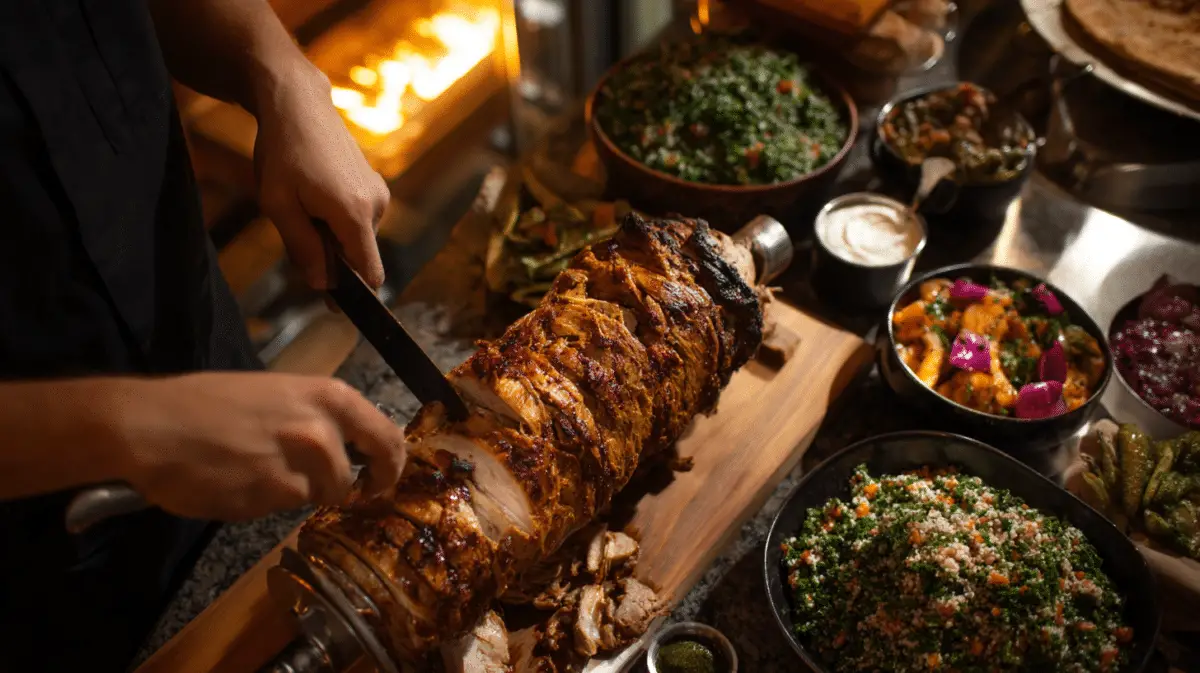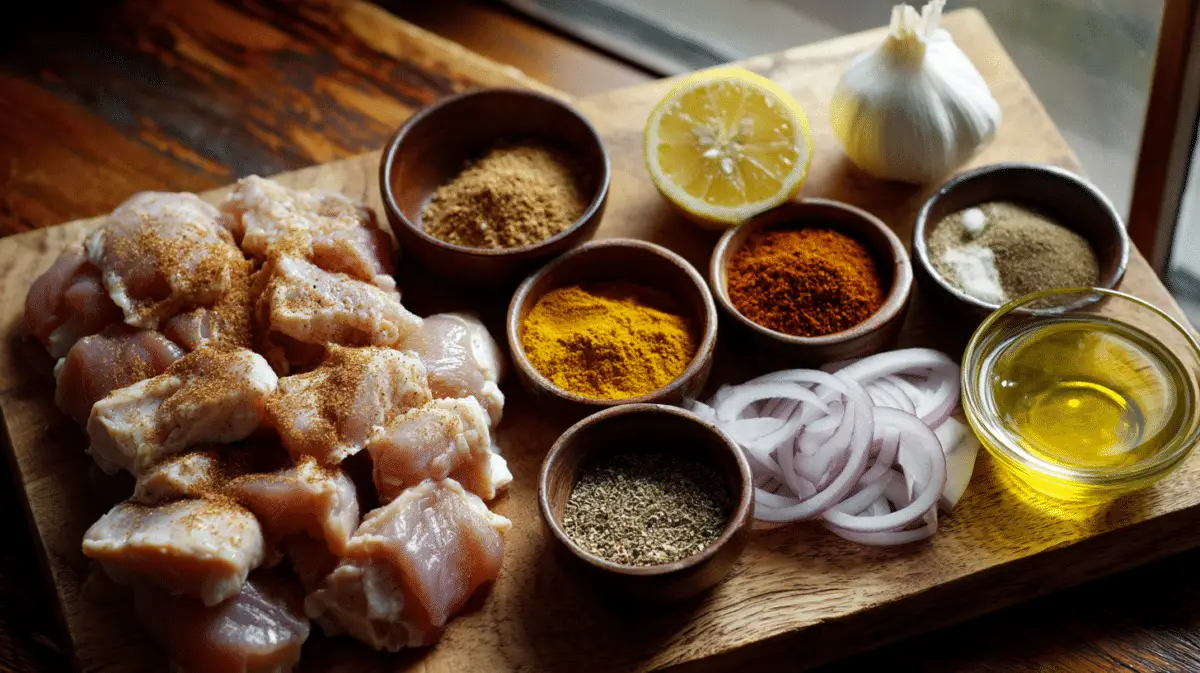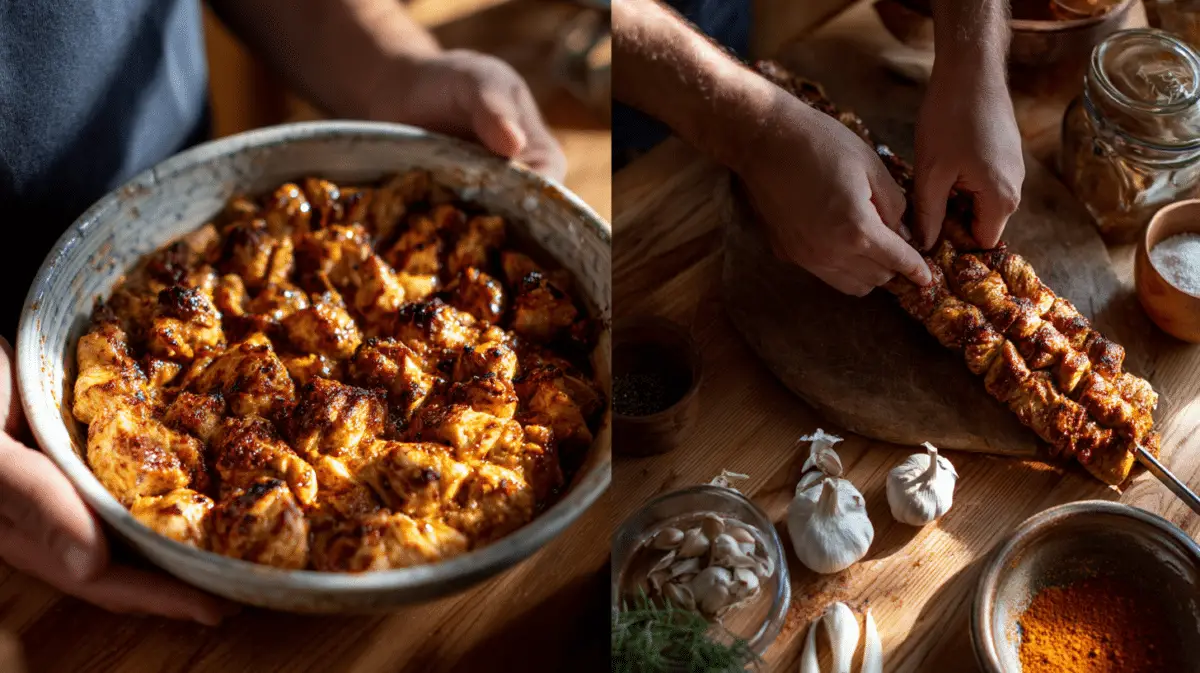Origins and Cultural Significance
Chicken shawarma, a popular Middle Eastern dish, has a rich history and strong cultural significance. It originated in the Levant region and has been cherished as a favorite street food, known for its flavorful spices and delicious taste. Traditionally cooked on a vertical rotisserie, shawarma has come to represent shared meals and lively gatherings.

Beyond its Middle Eastern roots, chicken shawarma has gained worldwide popularity, winning hearts in many cuisines. From food trucks in New York to cafes in Paris, its savory smell and tender texture have made it a global favorite.
For another rotisserie recipe, explore Grilled Chicken Shawarma on a Spit to master this cooking technique.
Popularity Across the Globe
What makes shawarma such a hit? It’s versatile, flavorful, and incredibly satisfying. Whether wrapped in warm pita bread, served over rice, or paired with tangy sauces like tahini or garlic aioli, shawarma adapts to various palates. Its global appeal lies in its ability to bring comfort and excitement to the table.
Understanding the Rotisserie Method
Benefits of Using a Rotisserie for Shawarma
Cooking shawarma on a rotisserie improves its flavor and texture. The rotating motion cooks the meat evenly, making it tender, juicy, and nicely crisp on the outside. This method is similar to the traditional vertical spit used in Middle Eastern kitchens, keeping the original style while being easy to use at home.
For a different take on Mediterranean cuisine, check out this Mediterranean Salmon Recipe that also emphasizes balanced flavors.
Differences Between Vertical and Horizontal Rotisseries
While both types of rotisseries can deliver excellent results, there are key distinctions:
- Vertical Rotisserie: The meat is stacked upright, with heat applied from the sides. This method allows fat to drip down, keeping the meat moist and flavorful.
- Horizontal Rotisserie: Here, the meat is laid across a horizontal skewer. Heat is distributed evenly as the spit rotates, which works well for smaller portions or when cooking in a home oven.
Essential Ingredients for Authentic Flavor
Selecting the Right Cuts of Chicken

The type of chicken you use is important for getting the perfect shawarma texture. Skinless, boneless chicken thighs are the best choice because they are tender and juicy. If you prefer a leaner option, chicken breasts can work, but you need to be careful to keep them from drying out.
For a quick yet flavorful chicken dish, try Greek Chicken Bites as an easy alternative.
Key Spices and Their Roles
Authentic shawarma flavor comes from a symphony of spices. Common staples include:
- Cumin: Earthy and warm, it forms the spice base.
- Paprika: Adds mild heat and a rich color.
- Turmeric: Lends a golden hue and subtle bitterness.
- Cinnamon: Balances savory with a hint of sweetness.
- Garlic Powder: Infuses depth and aroma.
These spices, when combined, create shawarma’s signature taste—bold, smoky, and aromatic.
Importance of Marinades and Resting Times
A marinade is the secret to making shawarma tender and full of flavor. It not only seasons the chicken but also softens the meat, giving it a juicy texture. Letting the chicken sit in the marinade, ideally overnight, makes the flavors even stronger, ensuring every bite is packed with taste.
For slow-cooked chicken recipes with deep flavor, explore Slow Cooker French Onion Soup Mix Chicken.
Preparing the Marinade
Step-by-Step Guide to Creating a Balanced Marinade
Crafting the perfect shawarma marinade requires a balance of spices, acidity, and fat. Here’s how to do it:

- Choose your base: Greek yogurt or olive oil for richness.
- Add acidity: Lemon juice or vinegar for a tangy kick.
- Mix the spices: Combine cumin, paprika, turmeric, and cinnamon in a bowl.
- Sweeten slightly: Add a touch of honey or sugar to round out the flavors.
- Garlic and onion: Grated for maximum flavor infusion.
Combine all the ingredients, ensuring they’re well-blended. The result? A marinade that hugs every inch of your chicken with bold, irresistible flavor.
Tips for Achieving Deep Flavor Penetration
For the marinade to work its magic:
- Score the chicken lightly with a knife to let the spices seep in.
- Massage the marinade into the meat for even coating.
- Use a zip-top bag or airtight container to marinate—this helps the flavors distribute evenly.
Marinating the Chicken
Optimal Marination Duration
Patience is important! Let the chicken marinate for at least 4-6 hours, though overnight is best. This extra time helps the flavors soak into the meat, making every bite deliciously spiced. If you’re in a hurry, 30 minutes can work, but the flavor won’t be as strong.
Techniques for Even Coating
To achieve consistent flavor in every piece:
- Place the chicken and marinade in a large bowl or bag.
- Toss and massage thoroughly, ensuring the spices cling to the chicken.
- Rotate the pieces halfway through marination for uniform coverage.
Want an extra burst of flavor? Reserve some marinade to baste the chicken as it cooks on the rotisserie.
Setting Up the Rotisserie
Equipment Needed
To cook chicken shawarma on a rotisserie, you’ll need the right tools to get the job done. Here’s a checklist:
- Rotisserie Spit and Motor: A sturdy spit to skewer the chicken and a reliable motor to rotate it.
- Heat Source: A grill, oven, or dedicated rotisserie machine.
- Meat Clamps or Forks: These secure the chicken, keeping it in place as it rotates.
- Drip Tray: Essential for catching juices and preventing messes.
- Thermometer: To monitor internal temperatures for perfectly cooked chicken.
Each piece of equipment ensures a smooth cooking process and a professional result at home.
Proper Skewer Placement and Balancing
Positioning the chicken correctly on the rotisserie skewer is crucial. Follow these steps:
- Layer the Chicken: If using multiple pieces, stack them tightly to create a compact mass. This prevents uneven cooking.
- Secure with Forks: Use rotisserie forks to lock the chicken in place, ensuring it doesn’t wobble as it rotates.
- Center the Weight: Distribute the chicken evenly along the skewer. An unbalanced skewer can strain the motor and lead to uneven cooking.
Take your time with this setup—it’s the foundation of a successful shawarma.
Safety Precautions
Safety first! While rotisserie cooking is fun, follow these tips to stay safe:
- Check the Rotisserie Motor: Ensure it’s securely attached and functioning properly before starting.
- Avoid Overloading: Too much weight can cause the skewer to slip or the motor to fail.
- Handle with Care: Use heat-resistant gloves when handling the skewer, especially during and after cooking.
- Monitor Cooking: Never leave the rotisserie unattended for long periods.
Mastering Chicken Shawarma on a Rotisserie
Chicken shawarma is one of the most beloved Middle Eastern dishes, known for its juicy, tender meat, aromatic spices, and crispy edges. Traditionally cooked on a vertical rotisserie, this homemade version uses a rotisserie spit for an authentic taste.
- Prep Time: 20 minutes
- Cook Time: 1 hour
- Total Time: 1 hour 20 minutes
- Yield: 5 people 1x
- Category: Main Course, Mediterranean Cuisine
- Cuisine: Mediterranean, Turkish
Ingredients
For the Chicken Marinade
- 2 lbs 900g boneless, skinless chicken thighs (or use chicken breasts for a leaner option)
- ¼ cup Greek yogurt (for tenderness, optional)
- 3 tablespoons olive oil
- Juice of 1 lemon
- 3 cloves garlic (minced)
- 1 teaspoon salt
- ½ teaspoon black pepper
- 1 teaspoon ground cumin
- 1 teaspoon ground coriander
- 1 teaspoon paprika
- ½ teaspoon ground turmeric
- ½ teaspoon ground cinnamon (adds warmth, optional)
- ¼ teaspoon cayenne pepper (for mild heat, adjust to preference)
- 1 teaspoon sumac or smoked paprika (for a tangy depth of flavor, optional)
For Serving
- Warm pita bread or flatbread
- Tahini sauce or garlic sauce (toum)
- Sliced cucumbers (tomatoes, and red onions)
- Pickled turnips or olives
- Cooked rice (for shawarma bowls)
Instructions
Step 1: Prepare the Marinade
- In a large bowl, whisk together Greek yogurt, olive oil, lemon juice, garlic, salt, and all the spices.
- Add the chicken thighs, coating them thoroughly in the marinade.
- Cover and marinate in the fridge for at least 4 hours, but overnight (12 hours) is ideal for the best flavor.
Step 2: Skewer and Set Up the Rotisserie
- Remove the marinated chicken from the fridge 30 minutes before cooking to bring it to room temperature.
- Layer the chicken onto a rotisserie skewer, stacking the thighs tightly to create a compact shape.
- Secure the chicken in place using rotisserie forks or clamps.
- Preheat the rotisserie grill or oven to 375°F (190°C).
Step 3: Cook on the Rotisserie
- Place the rotisserie skewer into position and turn on the motor to rotate the chicken continuously.
- Cook for 45 minutes to 1 hour, or until the internal temperature reaches 165°F (74°C).
- For extra crispy edges, increase the heat to 450°F (230°C) for the last 5 minutes.
- (Alternative cooking methods: See section below for oven and grill adaptations.)
Step 4: Carve and Serve
- Once fully cooked, let the chicken rest for 5-10 minutes before slicing.
- Using a sharp knife, carve thin, even slices off the rotisserie.
- Serve immediately in pita wraps, shawarma bowls, or with grilled vegetables.
Nutrition
- Calories: 290
Cooking Process
Temperature Settings and Monitoring
Getting the temperature right is essential for tender, juicy shawarma.
- Grill or Oven Setting: Maintain a temperature of 375°F to 400°F (190°C to 200°C).
- Monitor Consistently: Use a meat thermometer to check the internal temperature. Chicken is safe to eat at 165°F (74°C).
- Rotisserie Speed: A slow, steady rotation ensures even cooking and prevents burning.
Proper temperature control makes the difference between dry, overcooked chicken and perfectly juicy shawarma.
Estimated Cooking Times
Cooking time varies depending on the thickness and quantity of chicken. As a general rule:
- Boneless chicken thighs take about 45 minutes to 1 hour.
- Larger batches may require an additional 10-15 minutes.
To check for doneness, insert a thermometer into the thickest part of the chicken. If it reads 165°F, it’s ready.
Achieving the Perfect Char and Juiciness
The hallmark of great shawarma is that balance between crispy edges and juicy interiors. Here’s how to nail it:
- Allow the chicken to cook longer near the heat source toward the end of the process to develop a flavorful char.
- Avoid frequent basting during the last 10 minutes to ensure the surface crisps up.
That caramelized char brings the authentic shawarma experience right to your table.
Carving the Shawarma
Techniques for Thin, Uniform Slices
Carving shawarma is an art. For those delicate, paper-thin slices:
- Use a Sharp Knife: A well-sharpened blade glides through the meat effortlessly.
- Carve Against the Grain: This technique enhances tenderness and creates that melt-in-your-mouth texture.
- Work in Layers: Slice off the crispy outer layer first, then rotate the skewer and carve again.
Keep a steady hand—it’s worth the effort when your plate fills with perfectly sliced shawarma.
Maintaining Safety While Carving
Hot meat and sharp knives can be a risky combination. Stay safe by:
- Using heat-resistant gloves to hold the skewer.
- Keeping your knife angled away from your body while slicing.
- Letting the meat rest for a few minutes after cooking to reduce steam burns.
Carving doesn’t have to be stressful; with a bit of patience, you’ll serve up a feast in no time.
Serving Suggestions
Traditional Accompaniments: Breads, Sauces, and Salads
Shawarma shines when paired with its classic sidekicks:
- Breads: Warm pita or fluffy flatbreads to wrap your shawarma.
- Sauces: Creamy garlic sauce, tangy tahini, or refreshing yogurt dips.
- Salads: Middle Eastern favorites like tabbouleh, fattoush, or cucumber-tomato salads for a vibrant touch.
These combinations turn your shawarma into a complete, satisfying meal.
Modern Twists and Presentations
Feeling adventurous? Modernize your shawarma with these ideas:
- Shawarma Bowls: Serve over a bed of quinoa, rice, or greens.
- Shawarma Tacos: Swap pita for soft tortillas and add some salsa for fusion flair.
- Loaded Fries: Top crispy fries with shawarma, sauces, and pickled veggies.
Experiment with these twists and watch your guests rave about your creativity.
Storing and Reheating Leftovers
Best Practices for Preserving Flavor and Texture
Got leftovers? Keep them fresh with these tips:
- Store Properly: Place shawarma in an airtight container and refrigerate within two hours of cooking.
- Reheat Gently: Use a skillet or oven to warm the meat without drying it out. Microwaving works too, but keep it brief to maintain juiciness.
Shawarma tastes just as good the next day when stored correctly.
Creative Uses for Leftover Shawarma
Leftovers can become entirely new dishes:
- Shawarma Stir-Fry: Toss with veggies and noodles for a quick dinner.
- Shawarma Pizza: Layer shawarma, cheese, and sauce on a pizza crust.
- Shawarma Wraps: Stuff into tortillas or flatbreads for a quick snack.
A little creativity goes a long way in making leftovers exciting.
Common Mistakes to Avoid
Over-Marinating or Under-Marinating
Timing is crucial with marination. Leaving the chicken in the marinade too long can overpower the natural flavor and result in a mushy texture. On the flip side, not marinating long enough can leave the chicken bland. Stick to the recommended 4-6 hours (or overnight for the best results).
Uneven Cooking Due to Improper Setup
An unbalanced skewer or unevenly stacked chicken can lead to frustrating results. You might end up with parts that are overcooked and others underdone. To prevent this:
- Double-check that the weight of the chicken is evenly distributed.
- Secure the skewer tightly and ensure it rotates smoothly.
Proper setup is the key to hassle-free, evenly cooked shawarma.
Health Considerations
Nutritional Benefits of Homemade Shawarma
Homemade chicken shawarma offers a healthier alternative to store-bought or takeout versions. When prepared at home:
- You control the ingredients, avoiding unnecessary additives and preservatives.
- Chicken is a lean protein source, rich in essential nutrients like vitamin B6 and niacin.
- The use of fresh herbs and spices adds antioxidants and anti-inflammatory properties.
Pair your shawarma with whole-grain breads and fresh salads for a balanced, nutrient-dense meal.
Adjusting Recipes for Dietary Needs
Shawarma can be customized to suit various diets:
- Low-carb: Skip the bread and serve over greens or cauliflower rice.
- Dairy-free: Replace yogurt-based marinades with olive oil and lemon juice.
- Gluten-free: Use gluten-free flatbreads or wraps.
With a few tweaks, you can enjoy this delicious dish while staying true to your dietary preferences.
Alternative Cooking Methods
Oven and Grill Adaptations for Those Without a Rotisserie
If you don’t own a rotisserie, don’t worry—you can still enjoy authentic shawarma at home:
- Oven Method:
- Arrange marinated chicken on a baking sheet and roast at 400°F (200°C) for 25-30 minutes. Flip halfway for even cooking.
- Finish under the broiler for 2-3 minutes to achieve that crispy, charred edge.
- Grill Method:
- Thread the chicken onto skewers and grill over medium heat, turning frequently until cooked through.
- Use indirect heat to prevent burning while maintaining juiciness.
Both methods deliver flavorful results, though they lack the rotating magic of a rotisserie.
Pros and Cons of Each Method
| Method | Pros | Cons |
|---|---|---|
| Oven | Convenient and hands-free | May lack charred, smoky flavor |
| Grill | Smoky flavor and slight charring | Requires more attention and flipping |
| Rotisserie | Even cooking and authentic texture | Requires specialized equipment |
Choose the method that suits your setup and time constraints.
Exploring Regional Variations
Differences in Spices and Preparation Across Cultures
Shawarma varies across regions, with spices and techniques reflecting local flavors:
- Middle Eastern Shawarma: Features warm spices like cinnamon, nutmeg, and cardamom.
- Turkish Döner: Often seasoned with milder spices and served with yogurt-based sauces.
- Greek Gyros: Includes Mediterranean herbs like oregano and served with tzatziki.
Each variation has its unique charm, making shawarma a dish that evolves with its surroundings.
Notable Regional Shawarma Styles
Here are some distinct shawarma styles worth exploring:
- Lebanese Shawarma: Known for its heavy use of garlic and pickled accompaniments.
- Egyptian Shawarma: Often includes a tangy tomato-based sauce.
- Israeli Shawarma: Frequently served with amba, a pickled mango condiment.
Dive into these regional takes to discover a whole new world of shawarma flavors.
Making chicken shawarma on a rotisserie brings the bold flavors of the Middle East straight to your kitchen. From choosing the right chicken cut to marinating, cooking, and serving, every step adds to a delicious dish that’s juicy, flavorful, and full of spices.
Whether you follow the traditional method or try creative twists, shawarma is a flexible dish that’s sure to delight. So, get your rotisserie (or oven or grill) ready and enjoy a tasty journey that’s as fun to make as it is to eat.
FAQs
Absolutely! Beef and lamb are excellent substitutes, offering richer and heartier flavors. Adjust cooking times and spices to complement the meat.
Store leftovers in an airtight container in the fridge for up to 3 days. For longer storage, freeze the cooked chicken and thaw it when needed.
Yes. Over-marinating can break down the meat’s texture, making it mushy. Stick to 24 hours maximum for optimal flavor and texture.
Add cayenne pepper or chili powder to the marinade for an extra kick. Serve with spicy sauces for an added layer of heat.
Of course! Substitute chicken with tofu, seitan, or jackfruit. Use the same spices and marinade for a plant-based twist on this classic dish.
Table of contents
- Origins and Cultural Significance
- Popularity Across the Globe
- Understanding the Rotisserie Method
- Essential Ingredients for Authentic Flavor
- Preparing the Marinade
- Marinating the Chicken
- Setting Up the Rotisserie
- Cooking Process
- Carving the Shawarma
- Serving Suggestions
- Storing and Reheating Leftovers
- Common Mistakes to Avoid
- Health Considerations
- Alternative Cooking Methods
- Exploring Regional Variations
- FAQs

